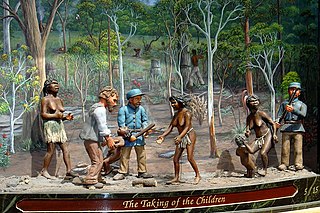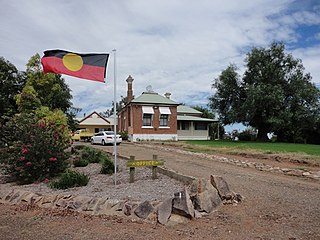Related Research Articles

The Stolen Generations were the children of Australian Aboriginal and Torres Strait Islander descent who were removed from their families by the Australian federal and state government agencies and church missions, under acts of their respective parliaments. The removals of those referred to as "half-caste" children were conducted in the period between approximately 1905 and 1967, although in some places mixed-race children were still being taken into the 1970s.
Keith Windschuttle is an Australian historian. He was appointed to the board of the Australian Broadcasting Corporation in 2006. He was editor of Quadrant from 2007 to 2015 when he became chair of the board and editor-in-chief. He was the publisher of Macleay Press, which operated from 1994 to 2010.
NAIDOC Week is an Australian observance lasting from the first Sunday in July until the following Sunday. The acronym NAIDOC stands for National Aborigines and Islanders Day Observance Committee, which was originally National Aborigines Day Observance Committee (NADOC). NAIDOC Week has its roots in the 1938 Day of Mourning, becoming a week-long event in 1975.

The Day of Mourning was a protest held by Aboriginal Australians on 26 January 1938, the 150th anniversary of the arrival of the First Fleet, which marked the beginning of the colonisation of Australia. It was declared to be a protest of 150 years of callous treatment and purposefully coincided with Australia Day celebrations. Day of Mourning protests have been held on Australia Day ever since 1938, though protests sharing its aims on this day are more commonly held under the names Invasion Day or Survival Day.

Pearl Mary (Gambanyi) Gibbs was an Indigenous Australian activist, and the most prominent female activist within the Aboriginal movement in the early 20th century. She was a member of the Aborigines Progressive Association (APA), and was involved with various protest events such as the 1938 Day of Mourning. She has strong associations with activists Jessie Street and Faith Bandler.

Burnum Burnum was an Aboriginal Australian sportsman, activist, actor, and author. He was a Woiworrung and Yorta Yorta man at Wallaga Lake in southern New South Wales. He was originally christened Harry Penrith but in 1976, he changed his name to Burnum Burnum after his grandfather both to honor him and acknowledge his Aboriginal identity.

The Aborigines Progressive Association (APA) was an Aboriginal Australian rights organisation in New South Wales that was founded and run by William Ferguson and Jack Patten from 1937 to 1944, and was then revived from 1963 until around 1970 by Herbert Groves.

The Yorta Yorta, also known as Jotijota, are an Aboriginal Australian people who have traditionally inhabited the area surrounding the junction of the Goulburn and Murray Rivers in present-day north-eastern Victoria and southern New South Wales.

Cummeragunja Reserve or Cummeragunja Station, alternatively spelt Coomeroogunja, Coomeragunja, Cumeroogunga and Cummerguja, was a settlement on the New South Wales side of the Murray River, on the Victorian border near Barmah. It was also referred to as Cumeroogunga Mission, although it was not run by missionaries. The people were mostly Yorta Yorta.
Marribank, earlier known as Carrolup, is a locality in the Shire of Kojonup, Western Australia, approximately 30 kilometres (19 mi) north-west of Katanning. It was the site of one of two large native settlements for Indigenous Australians established by the office of the Protector of Aborigines of the Western Australian state government. The settlement was one place that the Stolen Generations were taken after being separated from their families. Artworks produced by children at Carrolup are some of the only extant objects produced by members of the Stolen Generations across Australia.
The history of the Aboriginal inhabitants of Western Australia has been dated as existing for 50-70 thousand years before European contact. This article only deals with documented history from non indigenous sources since European settlement in Perth.

Half-Caste Act was the common name given to Acts of Parliament passed in Victoria and Western Australia in 1886. They became the model for legislation to control Aboriginal people throughout Australia - Queensland's Aboriginals Protection and Restriction of the Sale of Opium Act 1897, NSW/ACT's Aboriginal Protection Act 1909, the Northern Territory Aboriginals Act 1910, South Australia's Aborigines Act 1911, and Tasmania's Cape Barren Island Reserve Act 1912.

William Ferguson was an Aboriginal Australian leader.

The Australian Aborigines' League was established in Melbourne, Australia, in 1933 by William Cooper and others, including Margaret Tucker, Eric Onus, Anna and Caleb Morgan, and Shadrach James. Cooper was secretary of the League.
An Aboriginal reserve, also called simply reserve, was a government-sanctioned settlement for Aboriginal Australians, created under various state and federal legislation. Along with missions and other institutions, they were used from the 19th century to the 1960s to keep Aboriginal people separate from the white Australian population, for various reasons perceived by the government of the day. The Aboriginal reserve laws gave governments much power over all aspects of Aboriginal people’s lives.

The Cootamundra Domestic Training Home for Aboriginal Girls, commonly known as "Bimbadeen" and Cootamundra Girls' Home, located at Cootamundra, New South Wales operated by the New South Wales Aborigines Welfare Board from 1911 to 1968 to provide training to girls forcibly taken from their families under the Aborigines Protection Act 1909. These girls were members of the Stolen generations and were not allowed any contact with their families, being trained to work as domestic servants.
The Aboriginal South Australians are the Indigenous people who lived in South Australia prior to the British colonisation of South Australia, and their descendants and their ancestors. There are difficulties in identifying the names, territorial boundaries, and language groups of the Aboriginal peoples of South Australia, including poor record-keeping and deliberate obfuscation, so only a rough approximation can be given here.

The Australian Hall is a heritage-listed community building located at 150-152 Elizabeth Street, in the Sydney central business district, in the City of Sydney local government area of New South Wales, Australia. It was the site of the Day of Mourning protests by Aboriginal Australians on 26 January 1938. It was also known as the Cyprus Hellene Club. The property is owned by the Indigenous Land Corporation, a statutory corporation of the Australian Government. It was added to the Australian National Heritage List on 20 May 2008 and was added to the New South Wales State Heritage Register on 2 April 1999.

The Aborigines Protection Act 1909 (NSW) was an Act of the Parliament of New South Wales that repealed the Supply of Liquors to Aborigines Prevention Act 1867, with the aim of providing for the paternalistic protection and care of Aboriginal people in New South Wales. The originating bill was introduced to Parliament in the same year it was enacted, and was the first piece of legislation that dealt specifically with Aboriginals in the State.
Gerry Bostock was a Bundjalung activist, playwright, poet and filmmaker.
References
- ↑ "LOUSY LITTLE SIXPENCE". Ronin Films. Retrieved 3 January 2015.
- 1 2 3 4 Smith, Margaret. "25 years on, classic film still shocks" (PDF). Koori Mail . Retrieved 3 January 2015.
- ↑ Carrodus, Geraldine. "Lousy Little Sixpence, Stolen Generations and Land of the Little Kings: A Study Guide" (PDF). Ronin Films. Retrieved 3 January 2015.
- 1 2 "Lousy Little Sixpence (1983)". National Film and Sound Archive . Retrieved 5 January 2015.
- ↑ "Movies - Lousy Little Sixpence". www.CreativeSpirits.info. Retrieved 5 January 2015.
- ↑ "Lousy little sixpence [DVD]". Goulburn Valley Regional Library. Retrieved 5 January 2015.
- ↑ "Lousy Little Sixpence (1983)". IMDb . Retrieved 3 January 2015.